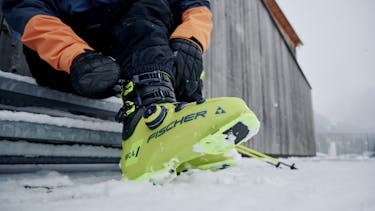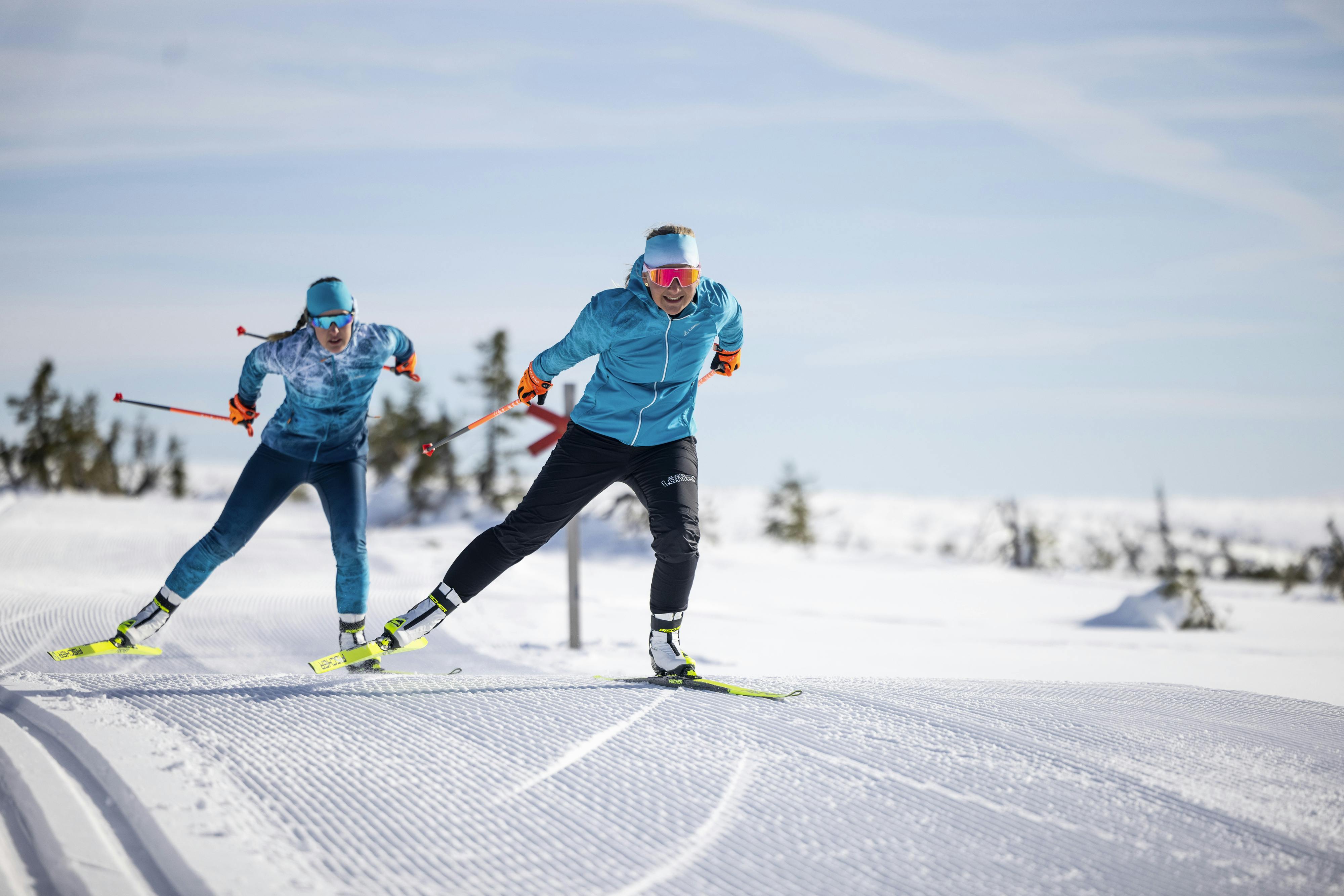What to look for when buying ski boots
Just like there are different skis for different styles and types of skiing, like freeride or touring, there are boots specifically designed to meet those same needs.
- For occasional skiers and typical slopes, comfort takes priority over all-out performance. Boots come with a numeric rating, called “flex index”, that tells you how stiff or forgiving the fit will be. These skiers will want less stiffness, which means a lower flex index number.
- For freeride skiing, protection and stability for the variety of conditions you’ll encounter are most important. Less weight is a consideration, as it makes short walking stretches easier. Less weight is also a major consideration for touring boots, which will have inserts for attachment to touring bindings. These boots come in a variety of stiffness ratings due to the wide array of skiing needs.
- Fast skiers and racers place a premium on an absolutely solid, secure boot for stability at high speeds and will seek a high flex rating.
No matter what type of skiing you do, look for the following features and benefits in any pair of good quality boots.
- Concentrate on both the foot and ankle areas to find the optimal fit. Boots are made to offer different amounts of volume for the foot, and different ways to adjust the ankle, or “cuff”. Minor internal adjustments can often be made with provided soft inserts. A loose boot means less control, less enjoyment, and less safety.
- Picture yourself skiing in deep snow, and be sure the boot is designed to keep snow out of the top of the cuff.
- There are boots available that have a focus on comfort and warmth, in particular, for skiers especially sensitive to cold.
- You won’t just be skiing in your boots. There is always a certain amount of walking, standing, and maybe hot cocoa drinking. Your boots need to perform when skiing and still be comfortable when walking.

What makes women’s, men’s, and kids’ boots different?
A women’s-specific boot is constructed with a narrower fit. A women’s boot also typically has a slightly lower flex index to better match a female’s lower body mass. Remember, less stiffness also means lower weight and increased comfort.
Children’s and junior boots will have an even lower flex index, which optimizes weight savings. The RC4 10 Junior Thermoshape, for example, has a flex index of 10. For stronger, larger juniors, a boot like the RC4 60 junior Thermoshape has a flex rating as high as 70.
The right Flex Index for you
Stiffer material is an advantage in performance and efficiency, but the trade-off is increased weight and potentially less comfort due to the more secure fit. In Fischer boot descriptions you will always find a listing for “stiffness”. The different grades of flex can be significant, so be sure to consider the trade-offs of a softer or harder boot.
Start with these general guidelines to determine the correct boot for you. Keep in mind that your style of skiing, ability, and body all come into play:
- Low to mid stiffness boots offer classic feel and performance for all-around skiers. These boots offer an ideal balance of support and stability along with day-to-day practicality. Read more about the RC4 90 HV as a good example.
- Mid to high (“hard”) stiffness boots are ideal for more serious frontside or freeride skiers. These skiers want basic comfort and a light boot, but need the stability that comes with added stiffness. Read more about the Ranger ONE 100 as a good example.
- Hard to very hard boots are for high speed, high precision, skiing and racing. Hard core skiers will gladly make trade-offs for the stability that comes with a very stiff boot. The RC4 Podium RD Worldcup STD is a great example.

Finding the right size
Time and effort spent on proper fitting boots are well worth the investment. In the long run, you will not be happy buying boots that are too large, hoping you can make them fit; or that a child will grow into a large boot in the future. The inner boot will change over time, making a less-than-ideal fit become a bad fit. Or you will have to crank the straps so tight that you create entirely new fit problems. So, whatever boots you choose, keep these guidelines in mind:
- Boots are best fit tested with proper ski socks on. Your foot will expand slightly throughout the course of a day, so try on boots later in the day, if possible. Ideally, the boot should fit snugly in the midfoot and in the heel. The ideal position for fitting is with your knees slightly bent in a skiing stance. Your toes shouldn’t contact the inner boot until you stand up.
- For children, proper fitting boot is essential to learn to ski properly. Not only can they be too tight, they may also be too high to allow proper movement. A gap of 1 – 1.5cm (± ½”) between toe tips and boot liner is a good guideline. Test boots with actual ski socks, and do it in the afternoon, when the foot has slightly expanded.

Mondopoint System and sole length
In an effort to simplify and standardize sizes across all brands, the Mondopoint System is used for ski boot sizes. It is based simply on the length of your foot in centimeters from your big toe to your heel. Ski stores will have a measuring device, and you can reference the table below. Our advice is to round upward as the better option if your foot falls in between two sizes.
| Mondopoint (cm) | European shoe size |
|---|---|
| 22,0 | 35 1/3 |
| 22,5 | 36 |
| 23,0 | 36 2/3 |
| 23,5 | 37 1/3 |
| 24,0 | 38 |
| 24,5 | 38 2/3 |
| 25,0 | 39 1/3 |
| 25,5 | 40 |
| 26,0 | 40 2/3 |
| 26,5 | 41 1/3 |
| 27,0 | 42 |
| 27,5 | 42 2/3 |
| 28,0 | 43 1/3 |
| 28,5 | 44 |
| 29,0 | 44 2/3 |
| 29,5 | 45 1/3 |
| 30,0 | 46 |
| 30,5 | 46 2/3 |
| 31,0 | 47 1/3 |
| 31,5 | 48 |
Sole length is not a factor in choosing boots or sizing, but it is a term you should be aware of. It is the measure of the outside bottom of the boot used to adjust the binding to properly fit the boot. Finding the right boot and having it fit properly aren’t magic. But when you do it right, it’s magical.
See you on the snow!



